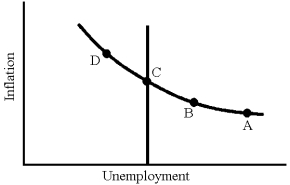A) worst recession occurs when output expands most rapidly.
B) slowest inflation occurs when output expands most rapidly.
C) slowest economic growth occurs when output grows most rapidly.
D) most rapid inflation occurs when output expands most rapidly.
Correct Answer

verified
Correct Answer
verified
Multiple Choice
Which term refers to provisions in a law or a contract whereby monetary payments are automatically adjusted whenever a specified price index changes?
A) Contango
B) Swap
C) Averaging
D) Indexing
Correct Answer

verified
Correct Answer
verified
Multiple Choice
Figure 17-7
 -In Figure 17-7, the case for restrictive monetary and fiscal policy is strongest at point
-In Figure 17-7, the case for restrictive monetary and fiscal policy is strongest at point
A) A.
B) B.
C) C.
D) D.
Correct Answer

verified
Correct Answer
verified
Multiple Choice
If actual inflation differs from expected inflation, what is the slope of the Phillips curve?
A) It is horizontal in the short and long run.
B) It is upward sloping in the short run and vertical in the long run.
C) It is vertical in the short run and upward sloping in the long run.
D) It is downward sloping in the short run and vertical in the long run.
Correct Answer

verified
Correct Answer
verified
Multiple Choice
A non-policy reason for the reduction in the natural rate of unemployment is the
A) expansionary nature of monetary policy.
B) aging of the U.S.labor force.
C) decline in interest rates.
D) growing federal budget surplus.
Correct Answer

verified
Correct Answer
verified
Multiple Choice
If aggregate demand in the U.S.had grown more slowly than it actually did in 2010, the
A) unemployment rate would have been even lower.
B) inflation rate would have been even lower.
C) unemployment rate would have been the same.
D) economy would have grown faster.
Correct Answer

verified
Correct Answer
verified
Multiple Choice
If AD and AS increase at exactly the same rate, the result will be
A) demand-side inflation.
B) supply-side inflation.
C) falling prices.
D) stable prices.
Correct Answer

verified
Correct Answer
verified
Multiple Choice
If workers and firms forecast inflation accurately,
A) the aggregate supply curve will be vertical.
B) the real wage will not decline as the price level rises.
C) workers will not lose from inflation, and firms will not gain.
D) All of the above are correct.
Correct Answer

verified
Correct Answer
verified
Multiple Choice
The unemployment rate for the U.S.economy in 2010 averaged about
A) 10 percent.
B) 8 percent.
C) 4 percent.
D) 2 percent.
Correct Answer

verified
Correct Answer
verified
Multiple Choice
When the aggregate supply curve shifts adversely, what happens to the relationship shown in the Phillips curve?
A) It is reinforced, and made more applicable for policy.
B) It is destroyed, and no longer applies for policy.
C) It is unchanged, although the curve becomes less steep.
D) It is unchanged, although the curve shifts inward and to the left.
Correct Answer

verified
Correct Answer
verified
Multiple Choice
Figure 17-7
 -In Figure 17-7, the case for expansionary monetary policy and fiscal policy is strongest at point
-In Figure 17-7, the case for expansionary monetary policy and fiscal policy is strongest at point
A) A.
B) B.
C) C.
D) D.
Correct Answer

verified
Correct Answer
verified
Multiple Choice
If business fluctuations are from demand-side forces,
A) monetary and fiscal policy will move inversely.
B) interest rates and budget deficits will move inversely.
C) unemployment and inflation will move inversely.
D) unemployment and budget deficits will move inversely.
Correct Answer

verified
Correct Answer
verified
Multiple Choice
In the 1990s, the United States benefited from a series of favorable supply shocks.This caused a(n)
A) increase in inflation and unemployment.
B) decrease in inflation and unemployment.
C) increase in inflation and a decrease in unemployment.
D) decrease in inflation and an increase in unemployment.
Correct Answer

verified
Correct Answer
verified
Multiple Choice
In 2008-2010, American policy makers decided to risk
A) higher inflation for the sake of decreasing unemployment.
B) higher unemployment to hold down inflation.
C) increasing taxes for the sake of reducing the budget deficit.
D) reducing government spending for the sake of balancing the budget.
Correct Answer

verified
Correct Answer
verified
Multiple Choice
The rapid advance in computer technology is one of the reasons given for the shift of the
A) aggregate demand curve outward.
B) aggregate supply curve inward.
C) aggregate supply curve outward.
D) total expenditures curve upward.
Correct Answer

verified
Correct Answer
verified
Multiple Choice
On the vertical axis, the Phillips curve depicts the
A) the rate of unemployment.
B) rate of inflation.
C) rate of growth of nominal GDP.
D) rate of growth of real GDP.
Correct Answer

verified
Correct Answer
verified
Multiple Choice
If the short-run Phillips curve has a very steep slope, the
A) structural deficit will grow during inflation.
B) structural deficit will fall during recession.
C) inflation costs of reducing unemployment are relatively low.
D) inflation costs of reducing unemployment are relatively high.
Correct Answer

verified
Correct Answer
verified
Multiple Choice
Politicians and economists who are generally conservative tend to believe that
A) the self-correcting mechanism is slow and unpredictable.
B) the short-run Phillips curve is relatively steep.
C) the costs of unemployment are high.
D) expectations in reaction to policy measures are very slow to change.
Correct Answer

verified
Correct Answer
verified
Multiple Choice
The proposition that the Fed should concentrate on price stability rather than reducing unemployment is
A) generally accepted by politicians, although few economists accept this proposal.
B) largely accepted by most economists, although politicians do not agree.
C) highly debatable, because many do not agree that price stability should be the most important goal.
D) simply incorrect, and no one accepts this idea anymore.
Correct Answer

verified
Correct Answer
verified
True/False
Demand-side inflation is usually accompanied by increasing real GDP, while supply-side inflation is usually accompanied by falling real GDP.
Correct Answer

verified
Correct Answer
verified
Showing 181 - 200 of 214
Related Exams